Zumasys - Rover ERP
Designing
an Adaptive AI
and UX System
From Spreadsheets to System: Redesign a Custom ERP in 90 Days
Result: 60% faster onboarding · 2.5x boost in operational efficiency · 99.3% data accuracy from day one

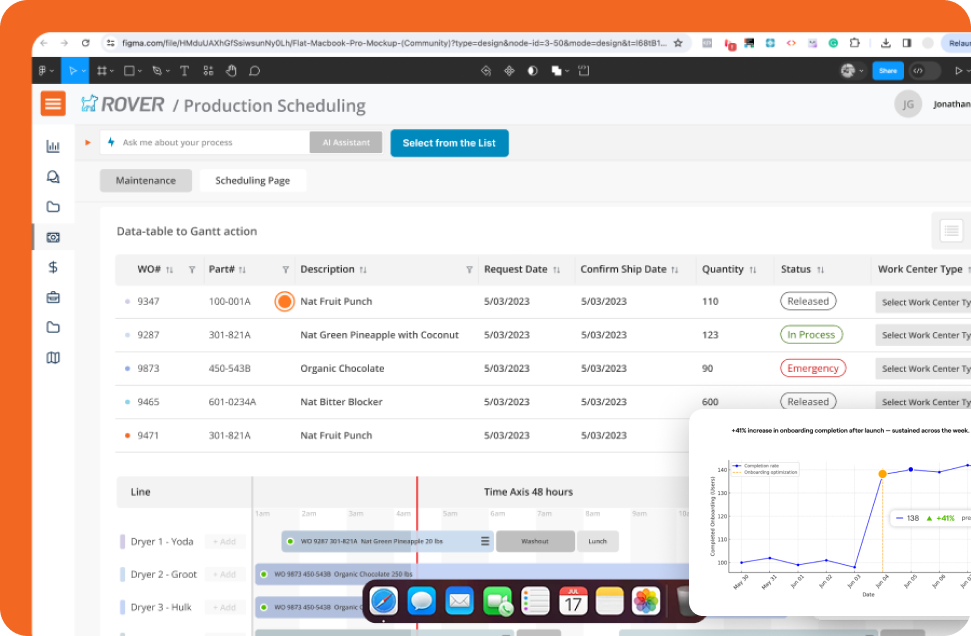
The AI Assistant in the header signals trust, showing the system
is ready to guide, recommend, and act for the user.
Completion rate
Onboarding optimization
Summary
I led UX architecture for a B2B SaaS ERP platform, integrating GPT-4 to deliver an AI-driven, behavior-adaptive onboarding experience that helps users reach value faster and with confidence.
Through intent-based flows, intelligent UI triggers, and cross-functional collaboration, we transformed onboarding from static tutorials into a dynamic system that adapts to user goals in real time.
Product Strategy
AI UX
Design Systems
Our goal
Turn it into an adaptive, AI-powered experience.
My role
Led UX strategy, prototyped prompt logic, connected Maze → Make → GPT-4 loop, validated with Mixpanel.
Results
✅ +41% onboarding completion
✅ 2.3× faster time-to-task
✅ +82% 3-week user retention
✅ +18% user clarity in Maze testing
✅ LTV/CAC ratio held strong at 4.0×
“The level of strategic
thinking, clarity of execution, and understanding of complex UX systems was outstanding. From research to final delivery, every step was thoughtful, fast, and deeply aligned with our goals. The collaboration felt like true partnership, not just a service.”
Mike Wright
Chief Technology Officer at Zumasys
Scope of Work
Rebuilding ERP Onboarding with LLMs:
UX Architecture for Activation at Scale
I led UX architecture for a B2B SaaS ERP platform, integrating GPT-4 to deliver an AI-driven, behavior-adaptive onboarding experience that helps users reach value faster and with confidence.
Through intent-based flows, intelligent UI triggers, and cross-functional collaboration, we transformed onboarding from static tutorials into a dynamic system that adapts to user goals in real time.
Tools:
Figma, GPT-4, API, Maze, Replit, Prompt Engineering, Mixpanel,
Notion, Make, Dovetail, Tokens Studio, Storybook
Business Problem
Before the redesign, only 42% of users completed onboarding, and 35% dropped off during the first session. The experience was static, overwhelming, and failed to adapt to user intent, with an average of 4 minutes to first value and CSAT stuck at 3.6.
“Too much information at once. I didn’t know what to do next.”
“Felt like I was on my own. No idea what that step meant.”
Through intent-based flows, intelligent UI triggers, and cross-functional collaboration, we transformed onboarding from static tutorials into a dynamic system that adapts to user goals in real time.
Results
We redesigned the flow architecture using LLM-powered logic that adapts in real time to user signals, improving completion rates, reducing churn, and accelerating product adoption.
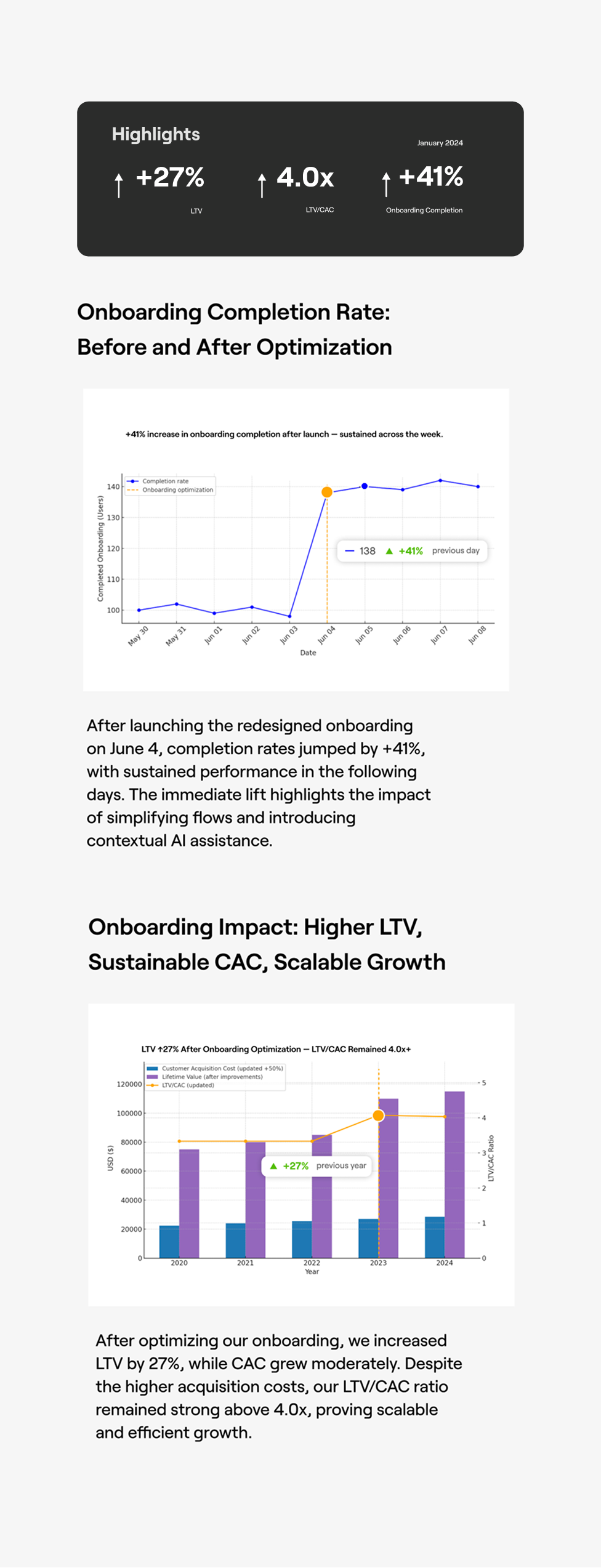
Data based on internal product analytics and post-launch cohort tracking. LTV/CAC metrics derived from financial reports.
Informal stakeholder sessions and collaborative ideation workshops helped uncover real workflow pain points, align on goals, and co-create early solution ideas.

Research
Conducted 12 interviews with ERP users across finance, operations, and logistics to identify onboarding friction and behavioral triggers.
Revealed pain points like interface overload, terminology gaps, and missing task context affecting retention.
Project Goals
- Improve user activation and reduce early churn
- Deliver adaptive onboarding using AI/LLM
- Align UX with user behavior and intent
- Scale the onboarding experience across roles
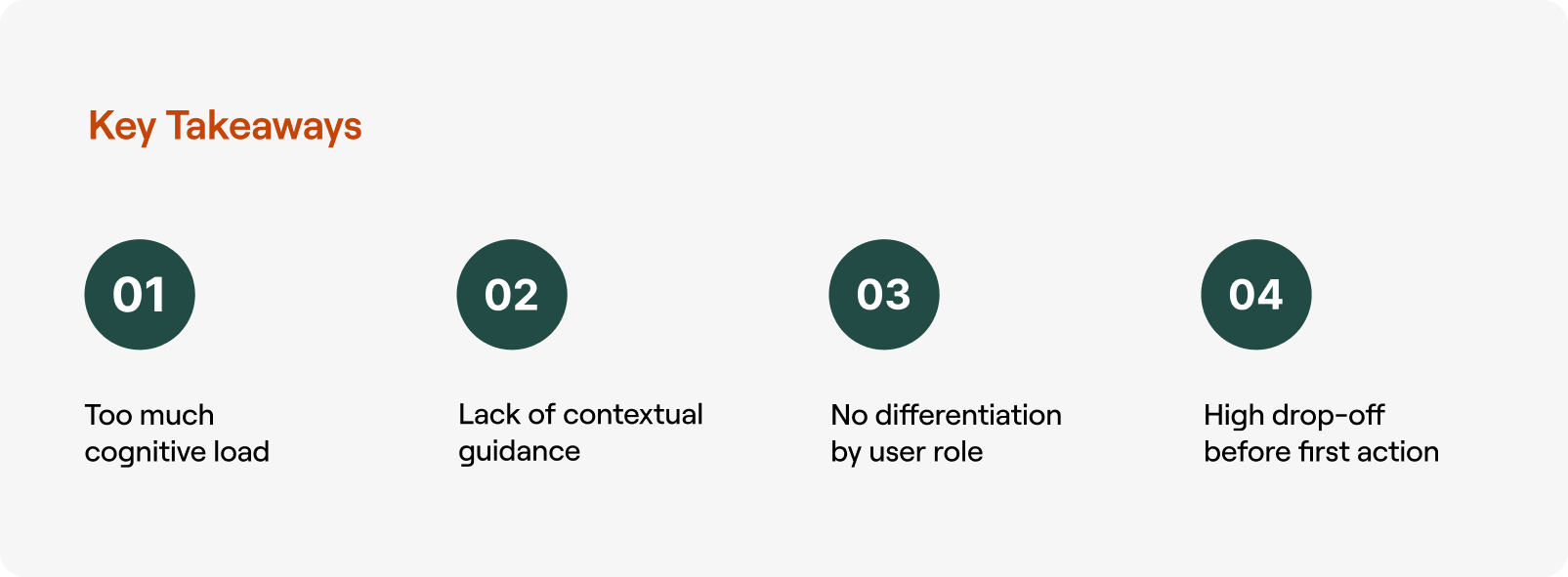
Fast Start from scetches

Rapid early sketching helped translate abstract ideas into tangible flows, enabling fast alignment and iterative feedback from the team.
User Flow
Mapped the full onboarding flow to reduce friction and user effort.
Optimized AI-assisted paths based on real interaction data.
Collaborated with engineers and product leads to align AI behavior with real workflows.
Owned UX-to-dev handoff to ensure clarity and seamless implementation.

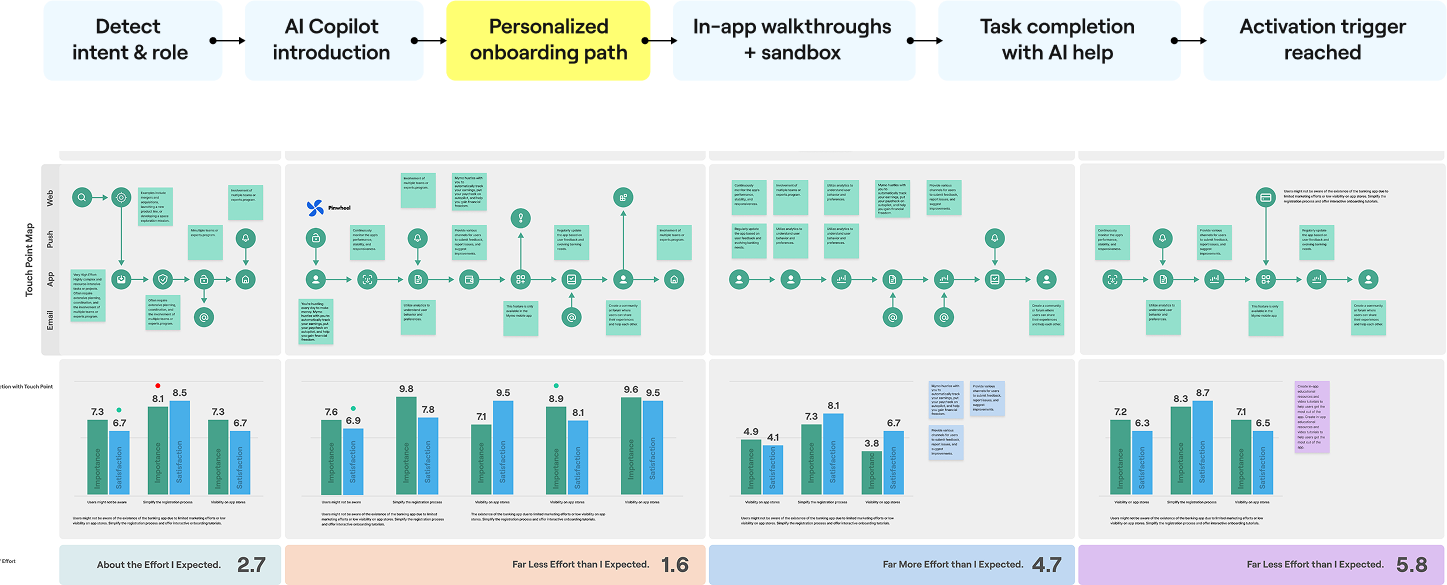
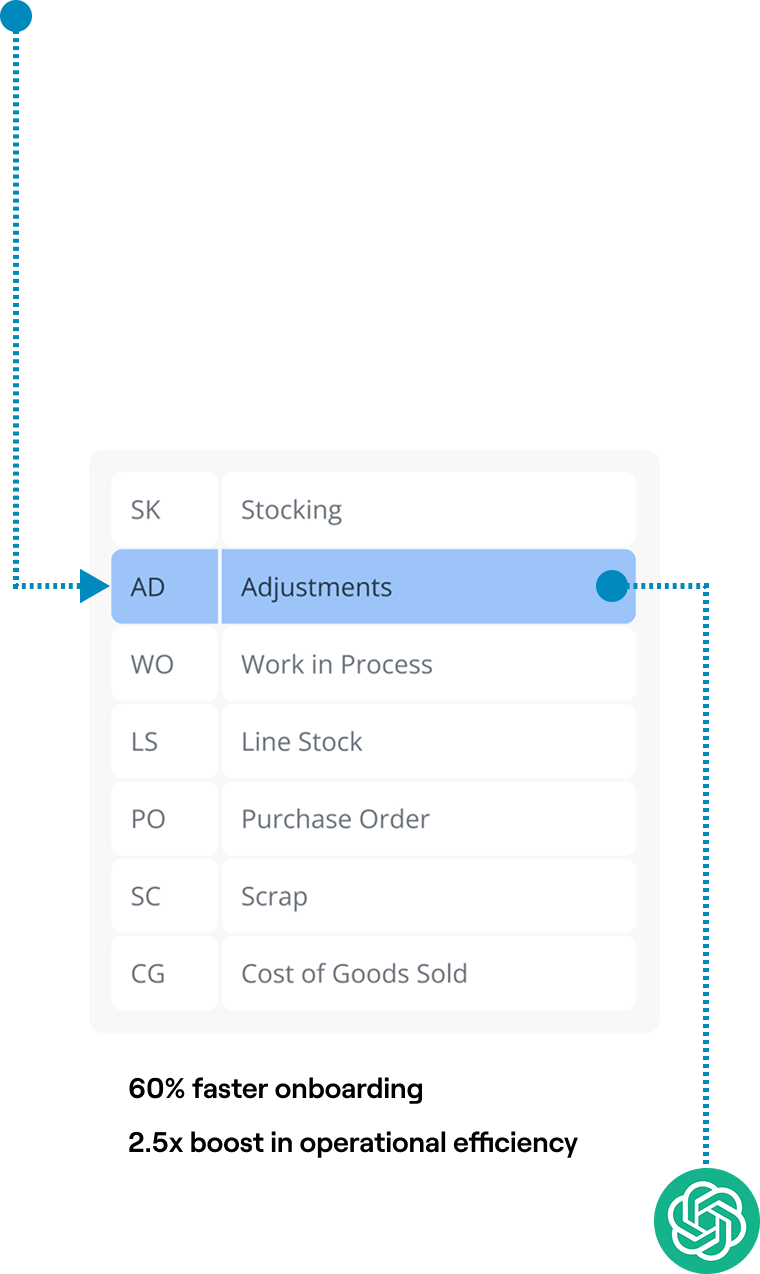
Idea
I led UX architecture for a B2B SaaS ERP platform, integrating GPT-4 to deliver an AI-driven, behavior-adaptive onboarding experience that helps users reach value faster and with confidence.
Through intent-based flows, intelligent UI triggers, and cross-functional collaboration, we transformed onboarding from static tutorials into a dynamic system that adapts to user goals in real time.
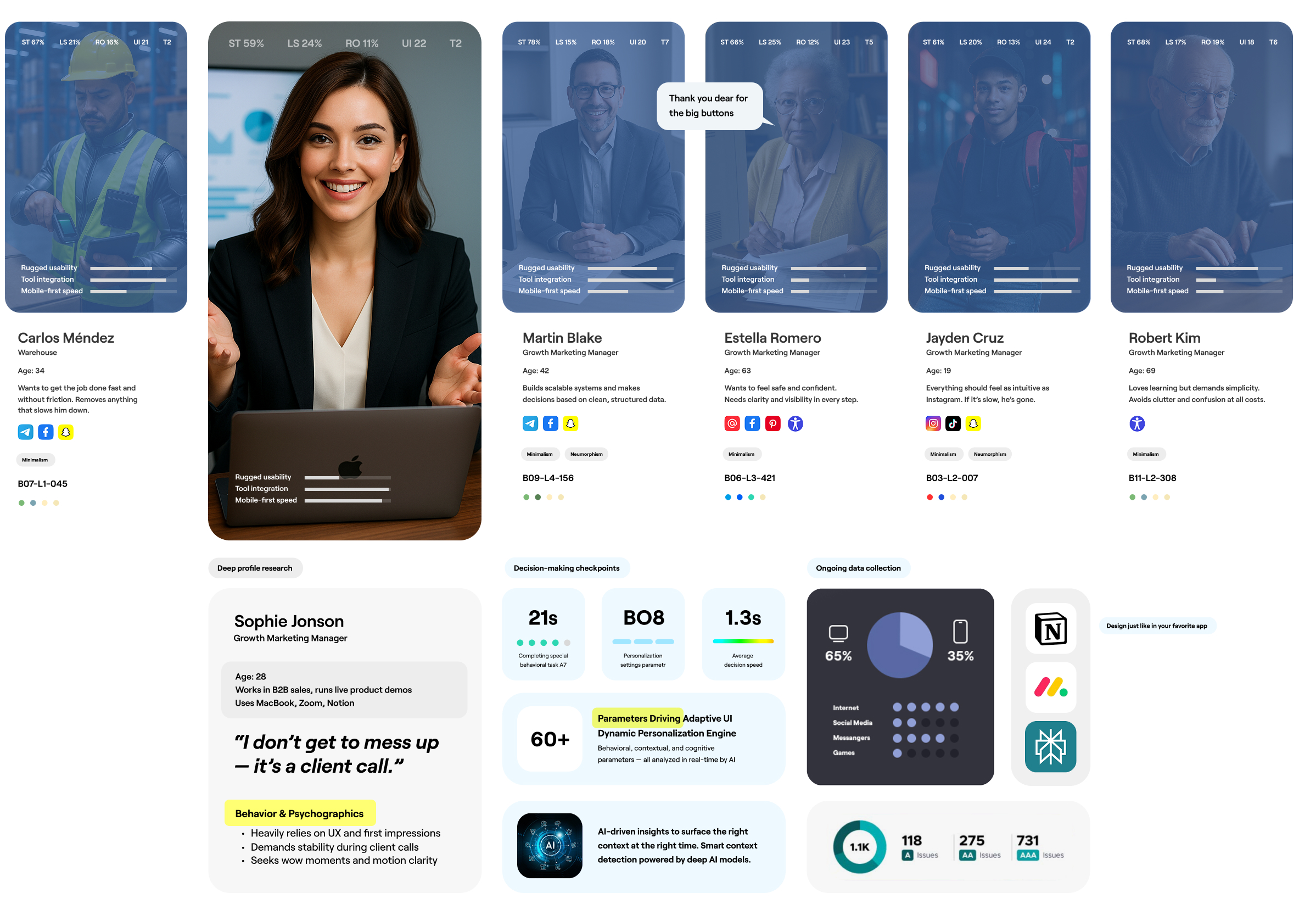
AI empowered profile
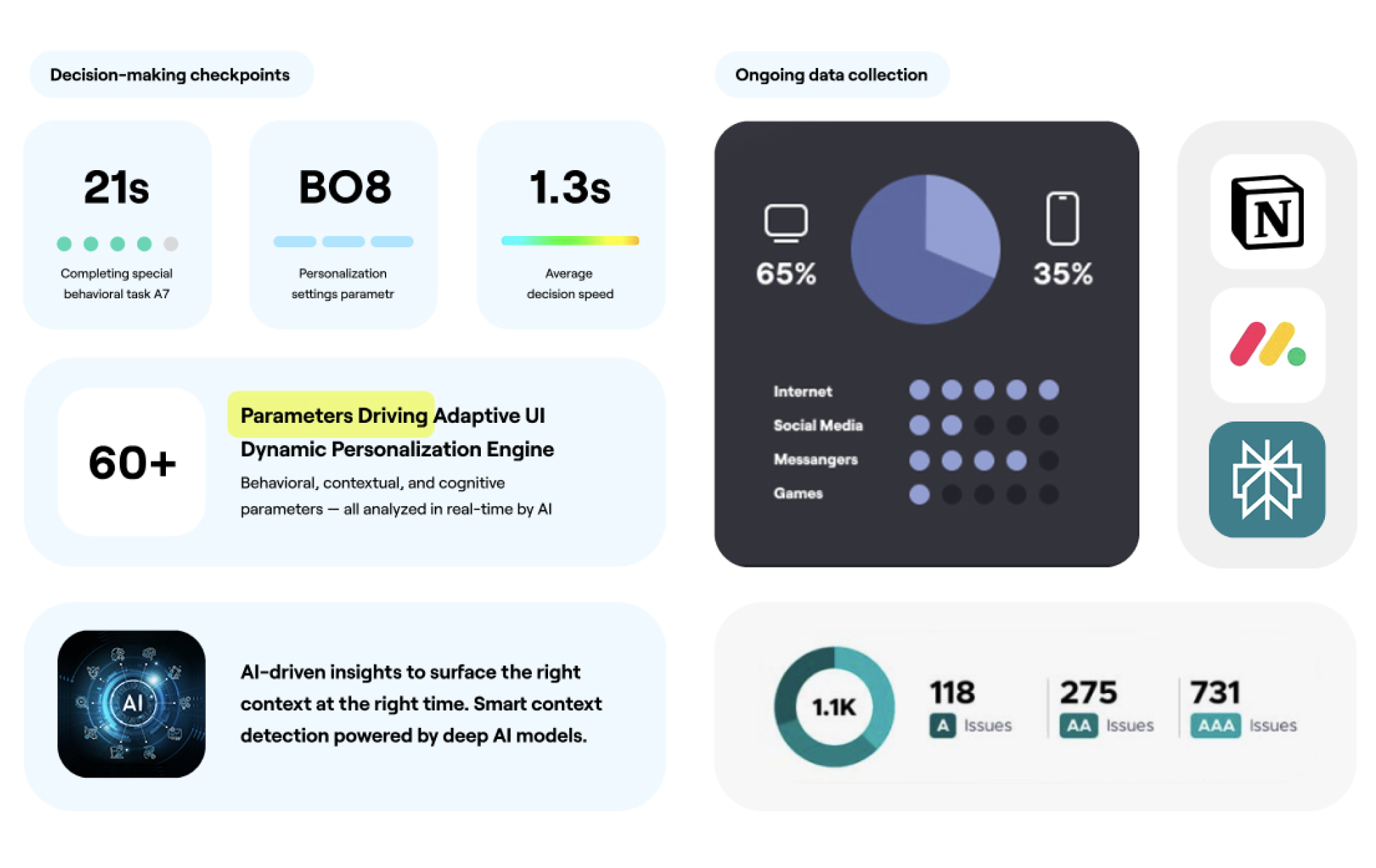
How AI-powered onboarding works
Behavior-driven LLM logic
We used Mixpanel to track user behavior in real time — scrolls, hesitations, retries — and routed those signals into the LLM. The AI adjusted onboarding flow based on actual intent, not static roles.
Dynamic step generation
Each onboarding path was generated based on user profile (finance lead vs ops manager) and their real-time interaction history. GPT-4 generated contextual steps that felt native, not scripted.
Contextual assistance
The AI Assistant didn’t just show help texts — it explained functions using business-relevant terminology, adapting tone and detail level based on user confidence and psychotype.
Real-time reactivity
With every interaction, the system updated UI focus, unlocked the next step, or simplified input fields — making onboarding feel like a smart conversation, not a form.
AI Hypothesis
LLM-powered logic helps users move forward based on context, not just pre-defined steps. Instead of a rigid walkthrough, we embed a real-time navigator directly into the UX architecture — adapting to role, intent, hesitation, and business goals. This approach transforms onboarding from "one-size-fits-all" to a responsive, AI-guided experience.
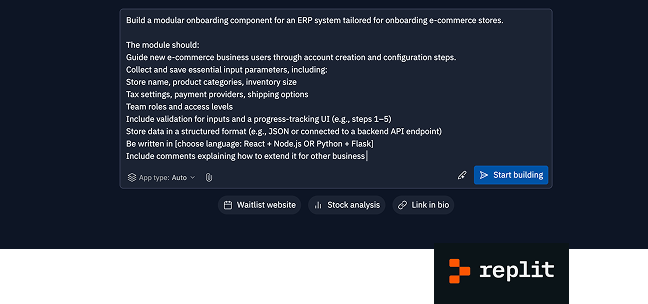
Replit
To test LLM behavior before full dev integration, I built live prototypes in Replit using the GPT-4 API, allowing the team to simulate onboarding conversations and iterate on prompt structure in real time.
- This allowed fast iteration without waiting on engineering.
- We simulated real user flows and adjusted logic based on immediate feedback.
- It gave the team clarity and confidence before committing to dev resources.
Prompt Engineering
I designed a modular prompt system that dynamically adapted to user roles and behavior in real time.
- Instead of static one-shot instructions, we used prompt chaining with controlled tone and verbosity to make the assistant feel intuitive and trustworthy.
- Triggers were based on behavior (e.g. idle time, input errors), not just clicks — and every interaction was logged via Mixpanel for analysis.
Used Mixpanel to track conversion, TTFA, and drop-off by cohort. Identified that users interacting with the AI assistant completed onboarding 2.3x more often. Used this insight to prioritize prompt sequencing and UI simplification.
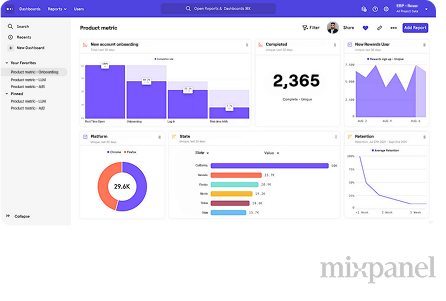
AI Maze usability tests
Conducted 3 rounds of Maze usability tests with ERP users. Identified confusion in step 3 of the adaptive flow and optimized AI handover. Resulted in +18% increase in perceived clarity (CSAT) and 12% higher task completion.
- These unmoderated tests surfaced hesitation zones and cognitive overload moments.
- The AI-enhanced version consistently scored higher on clarity and usefulness.
- Based on feedback, we fine-tuned walkthrough copy and flow structure.
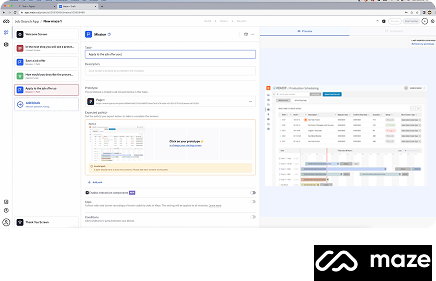
Make automation
I integrated Make as a no-code automation layer between design artifacts and UX data. This enabled real-time syncing between Notion (research + hypotheses), Figma prototypes, and Mixpanel dashboards, without writing a single line of backend code.
- Automated test cycles, connecting Figma ↔ Maze ↔ Mixpanel through Make scenarios
- Real-time research sync, user insights from interviews auto-synced into Notion
- Prompt iteration logs, storing GPT prompt variants & responses for review
- Frictionless A/B testing, swapping onboarding flows and logging outcomes without dev dependency
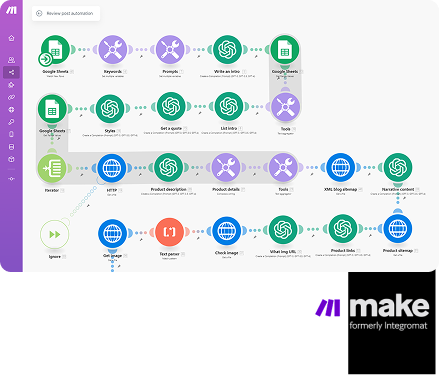
AI Hypothesis
I led UX architecture for a B2B SaaS ERP platform, integrating GPT-4 to deliver an AI-driven, behavior-adaptive onboarding experience that helps users reach value faster and with confidence.
Through intent-based flows, intelligent UI triggers, and cross-functional collaboration, we transformed onboarding from static tutorials into a dynamic system that adapts to user goals in real time.
I led UX architecture for a B2B SaaS ERP platform, integrating GPT-4 to deliver an AI-driven, behavior-adaptive onboarding experience that helps users reach value faster and with confidence.
Through intent-based flows, intelligent UI triggers, and cross-functional collaboration, we transformed onboarding from static tutorials into a dynamic system that adapts to user goals in real time.
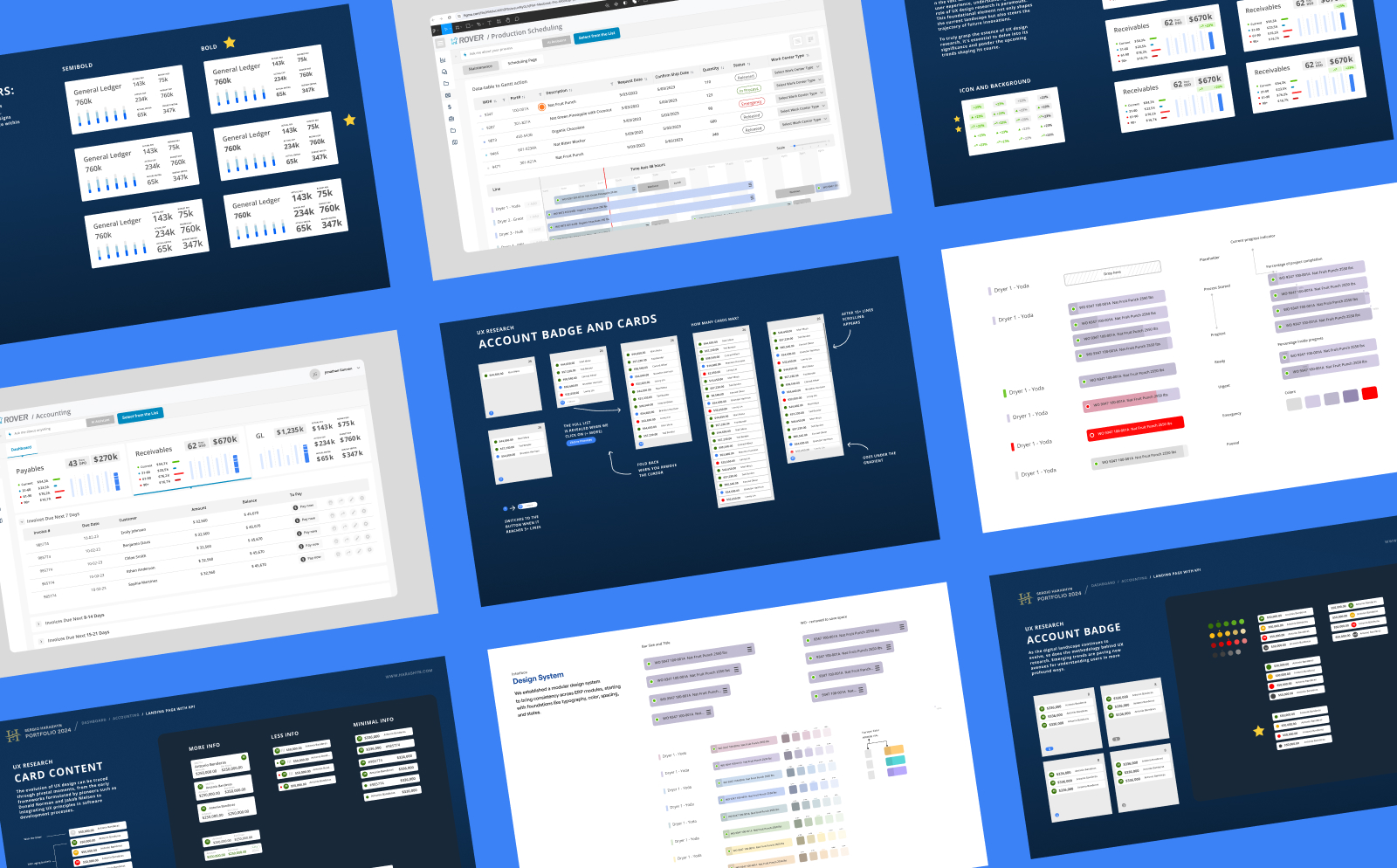
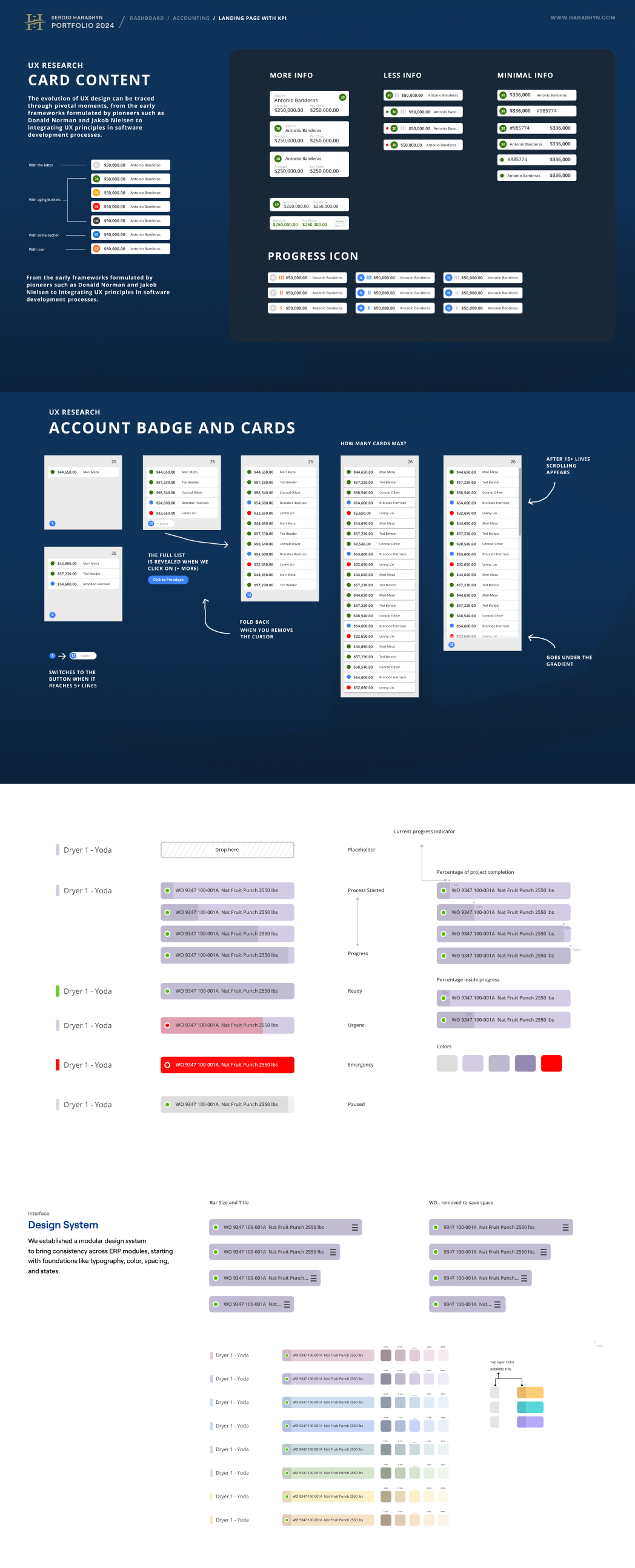
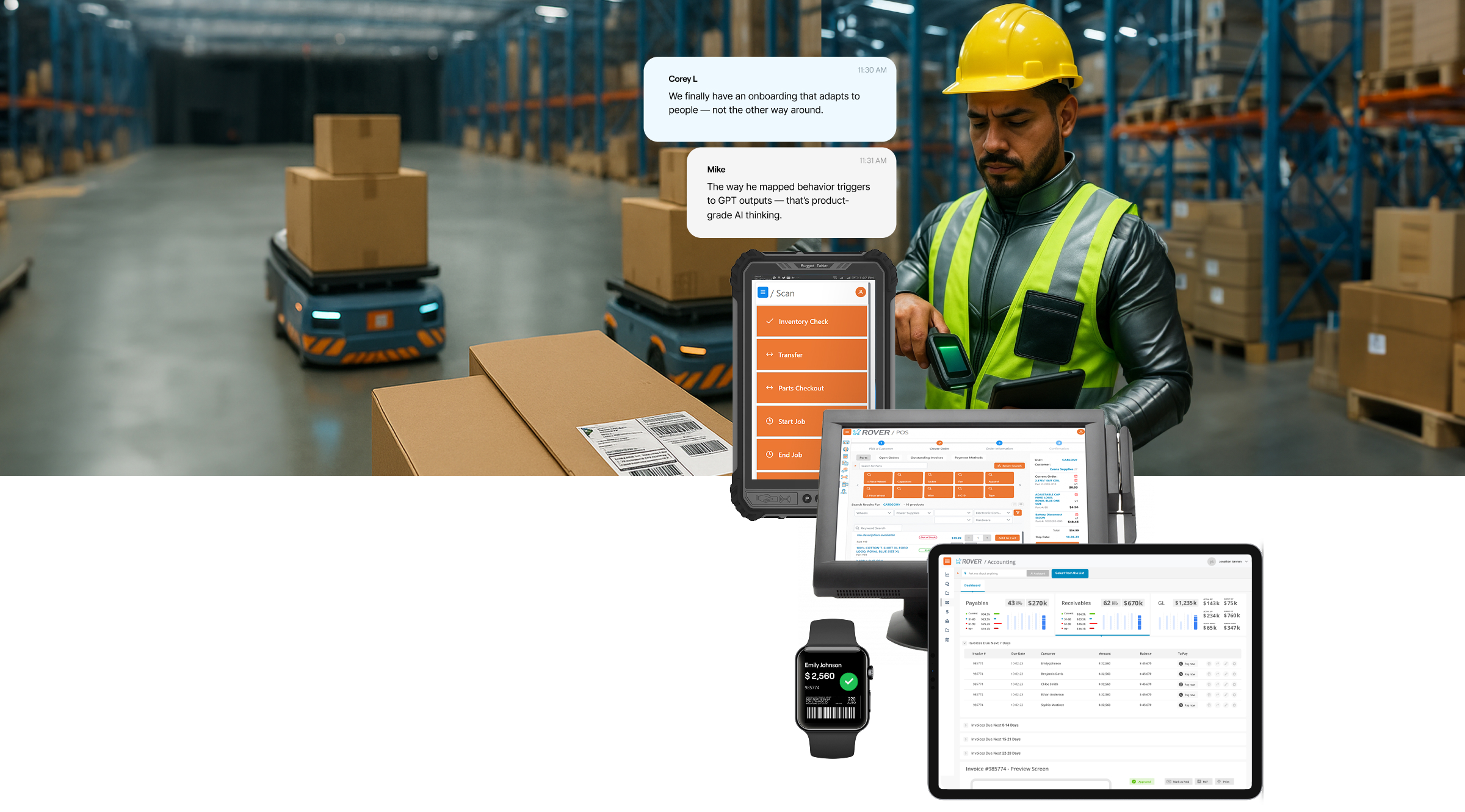
Learnings & Next Steps
Throughout the project, we uncovered
key insights about how users of different technical backgrounds interact with
AI-driven guidance. Behavior-based onboarding proved significantly more effective than static tutorials — but clarity and confidence varied by user psychotype.
Next, we plan to:
- A/B test various AI tone and guidance styles
to match different cognitive types - Expand contextual personalization across
other ERP modules - Integrate user sentiment signals to drive
next-step logic - Refactor prompt chains to increase task autonomy and reduce dependency on UI
Consistent
Design System
and AI tested
experience
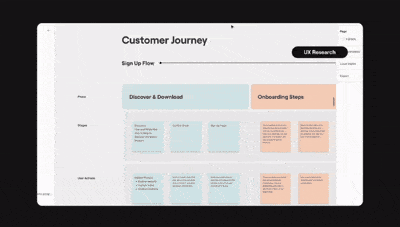
Other Projects
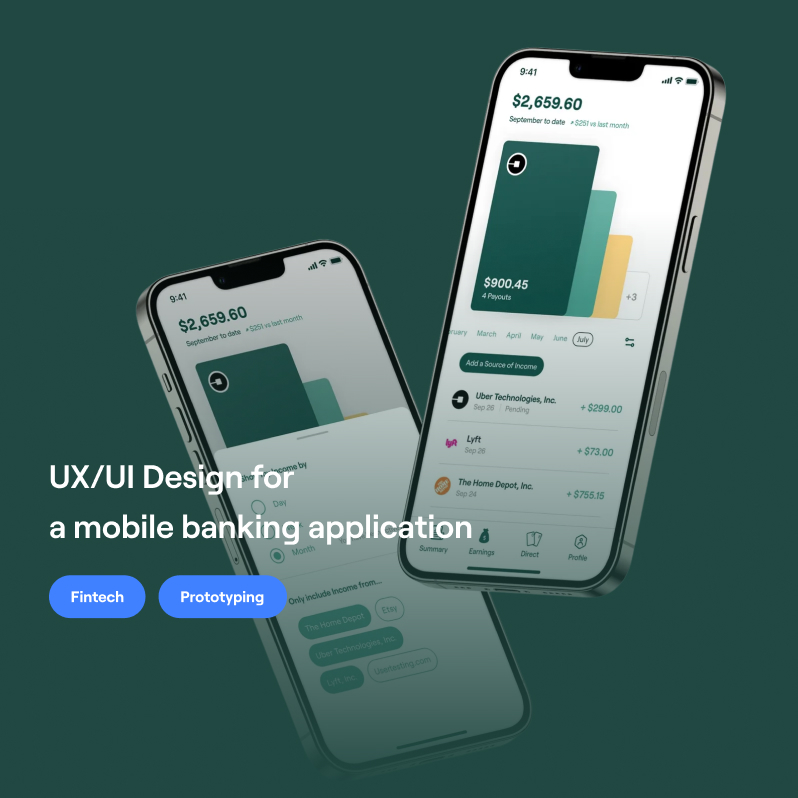
See Project
→

See Project
→
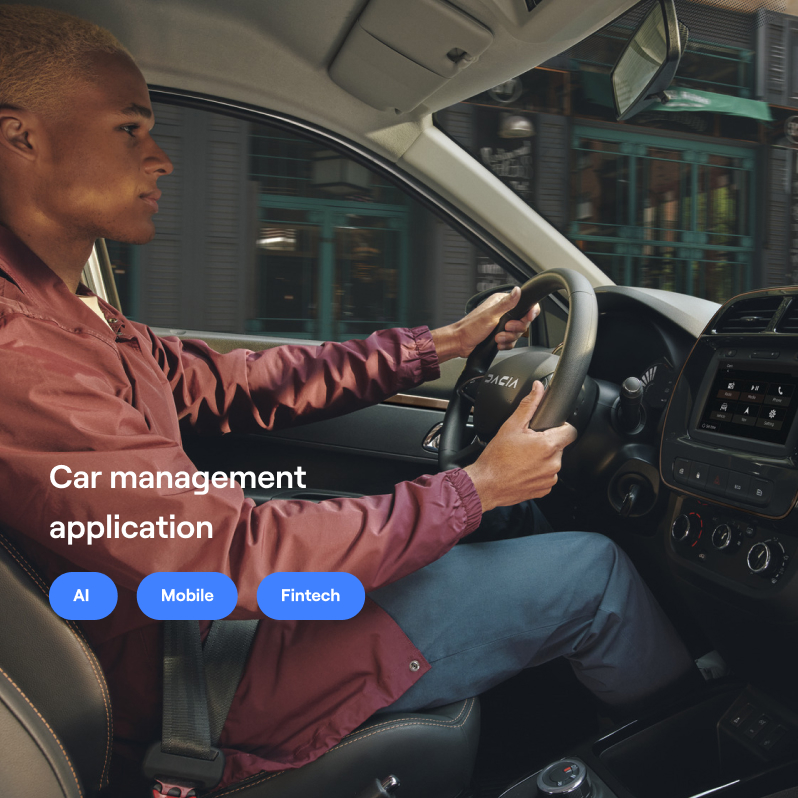
See Project
→
Schedule a call
© 2025 Designed by Sergio Harashyn

ABOUT
Manifest
My Passion
AI Research
UX Design Book
Free UX Resources
Build Your Personal Brand
CONTACT
(323) 614-7397
hello@figma.com
SOCIAL
Behance
Telegram

Sergio Harashyn
Menu
Work
About
Contact
Zumasys - Rover ERP
Designing an Adaptive AI and UX System
From Spreadsheets to System: Redesign a Custom ERP in 90 Days
Result: 60% faster onboarding · 2.5x boost in operational efficiency · 99.3% data accuracy from day one

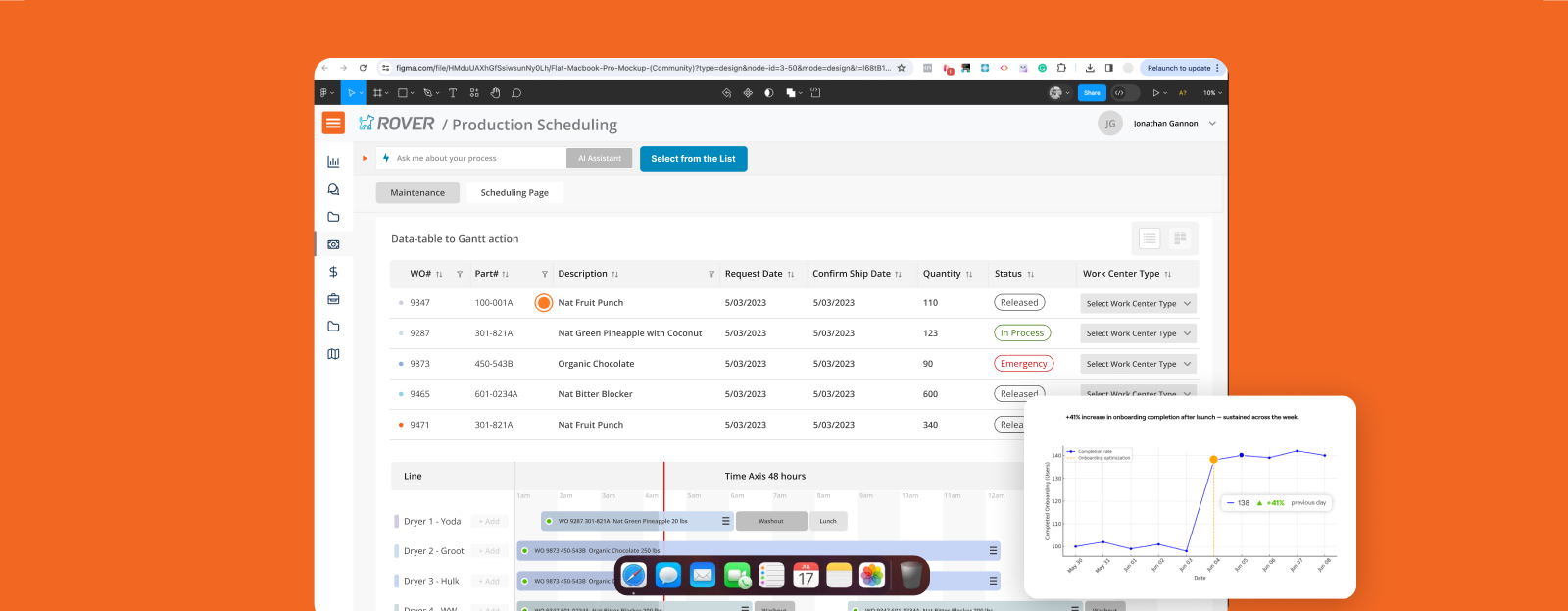
The AI Assistant in the header signals trust, showing the system
is ready to guide, recommend, and act for the user.
Summary
I led UX architecture for a B2B SaaS ERP platform, integrating GPT-4 to deliver an AI-driven, behavior-adaptive onboarding experience that helps users reach value faster and with confidence.
Through intent-based flows, intelligent UI triggers, and cross-functional collaboration, we transformed onboarding from static tutorials into a dynamic system that adapts to user goals in real time.
Product Strategy
AI UX
Design Systems
LLM Integration
Our goal
Turn it into an adaptive, AI-powered experience.
My role
Led UX strategy, prototyped prompt logic, connected Maze → Make → GPT-4 loop, validated with Mixpanel.
Results
✅ +41% onboarding completion (Mixpanel)
✅ 2.3× faster time-to-task (vs legacy flow)
✅ +82% 3-week user retention
✅ +18% user clarity in Maze testing
✅ LTV/CAC ratio held strong at 4.0×
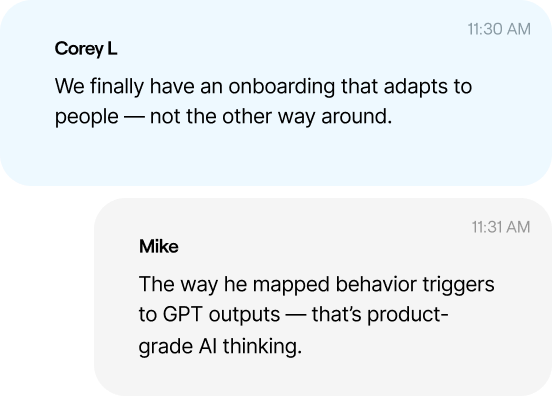
“The level of strategic thinking, clarity of execution, and understanding of complex UX systems was outstanding. From research to final delivery, every step was thoughtful, fast, and deeply aligned with our goals. The collaboration felt like true partnership, not just a service.”
Mike Wright
Chief Technology Officer at Zumasys
Motion UX in Action
Scope of Work
Rebuilding ERP Onboarding with LLMs:
UX Architecture for Activation at Scale
I led UX architecture for a B2B SaaS ERP platform, integrating GPT-4 to deliver an AI-driven, behavior-adaptive onboarding experience that helps users reach value faster and with confidence.
Through intent-based flows, intelligent UI triggers, and cross-functional collaboration, we transformed onboarding from static tutorials into a dynamic system that adapts to user goals in real time.
Tools:
Figma, GPT-4, API, Replit, Prompt Engineering, Mixpanel,
Maze, Notion, Make, Dovetail, Tokens Studio, Storybook
Business Problem
Before the redesign, only 42% of users completed onboarding, and 35% dropped off during the first session. The experience was static, overwhelming, and failed to adapt to user intent, with an average of 4 minutes to first value and CSAT stuck at 3.6.
Through intent-based flows, intelligent UI triggers, and cross-functional collaboration, we transformed onboarding from static tutorials into a dynamic system that adapts to user goals in real time.
“Too much information at once. I didn’t know what to do next.”
“Felt like I was on my own. No idea what that step meant.”
Results
We redesigned the flow architecture using LLM-powered logic that adapts in real time to user signals, improving completion rates, reducing churn, and accelerating product adoption.
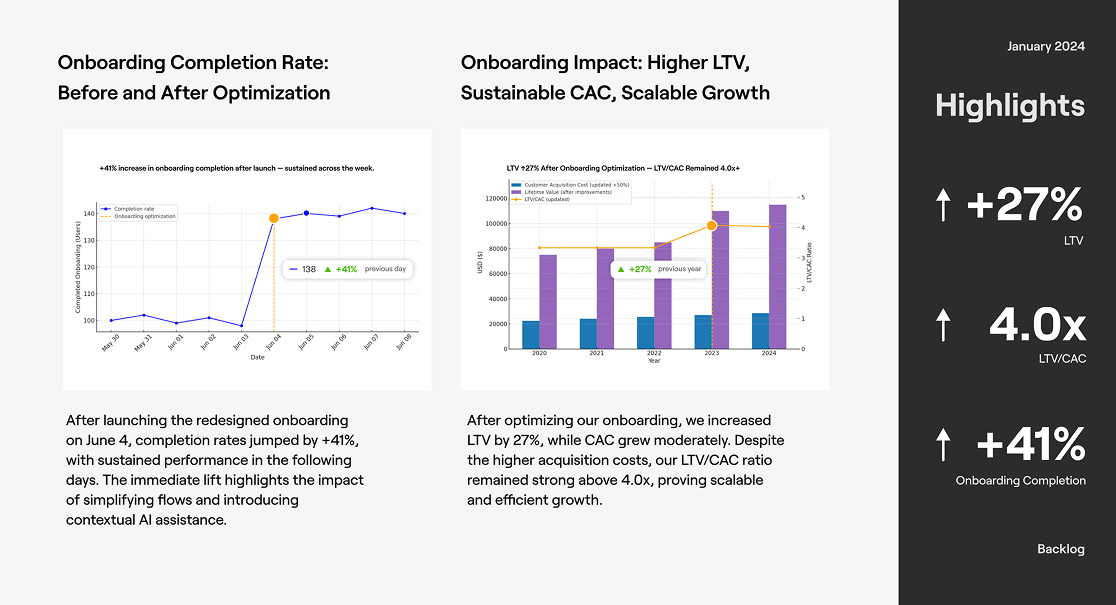
Informal stakeholder sessions and collaborative ideation workshops helped uncover real workflow pain points, align on goals, and co-create early solution ideas.
Data based on internal product analytics and post-launch cohort tracking.
LTV/CAC metrics derived from financial reports.

Results
Project Goals
Research
- Improve user activation and reduce early churn
- Deliver adaptive onboarding using AI/LLM
- Align UX with user behavior and intent
- Scale the onboarding experience across roles
Conducted 12 interviews with ERP users across finance, operations, and logistics to identify onboarding friction and behavioral triggers. Revealed pain points like interface overload, terminology gaps, and missing task context affecting retention.

Fast Start from scetches

Rapid early sketching helped translate abstract ideas into tangible flows, enabling fast alignment and iterative feedback from the team.
User Flow

Mapped the full onboarding flow to reduce friction and user effort.
Optimized AI-assisted paths based on real interaction data.
Collaborated with engineers and product leads to align AI behavior with real workflows.
Owned UX-to-dev handoff to ensure clarity and seamless implementation.

Idea
I led UX architecture for a B2B SaaS ERP platform, integrating GPT-4 to deliver an AI-driven, behavior-adaptive onboarding experience that helps users reach value faster and with confidence.
Through intent-based flows, intelligent UI triggers, and cross-functional collaboration, we transformed onboarding from static tutorials into a dynamic system that adapts to user goals in real time.

AI empowered profile
How AI-powered onboarding works
Behavior-driven LLM logic
We used Mixpanel to track user behavior in real time — scrolls, hesitations, retries — and routed those signals into the LLM. The AI adjusted onboarding flow based on actual intent, not static roles.
Dynamic step generation
Each onboarding path was generated based on user profile (finance lead vs ops manager) and their real-time interaction history. GPT-4 generated contextual steps that felt native, not scripted.
Contextual assistance
The AI Assistant didn’t just show help texts — it explained functions using business-relevant terminology, adapting tone and detail level based on user confidence and psychotype.
Real-time reactivity
With every interaction, the system updated UI focus, unlocked the next step, or simplified input fields — making onboarding feel like a smart conversation, not a form.
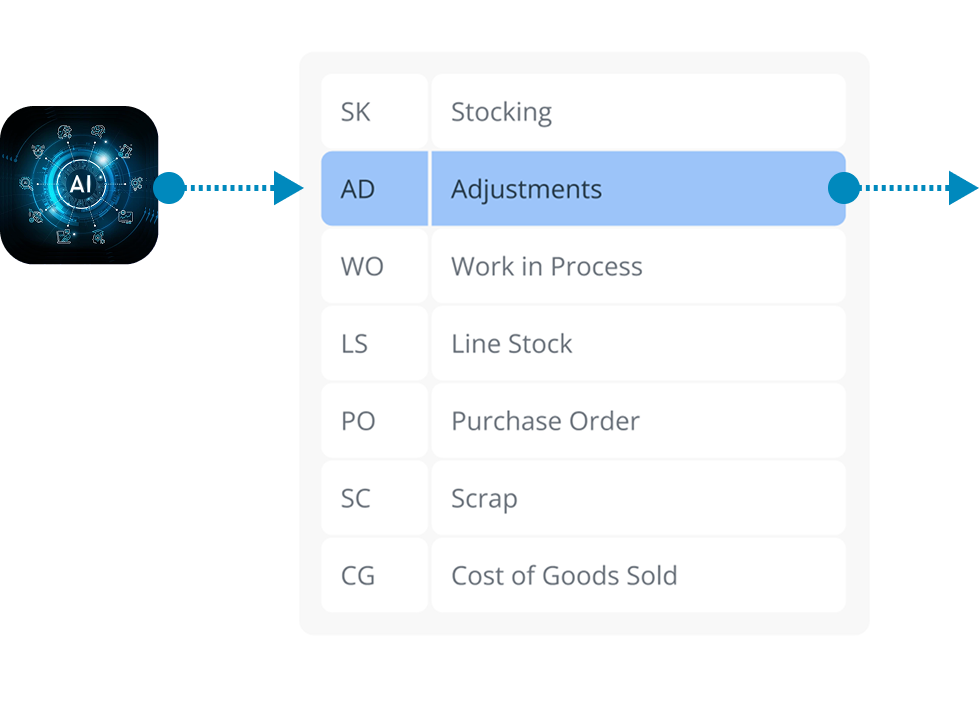
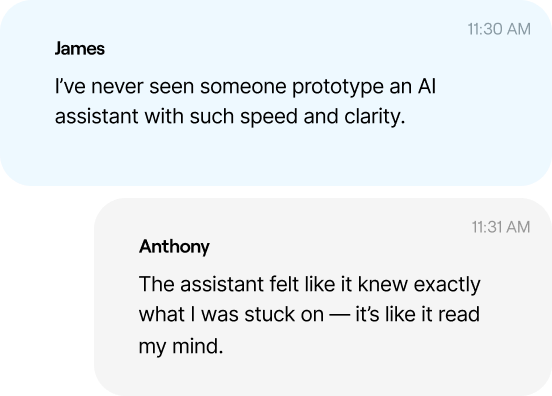
AI Hypothesis
LLM-powered logic helps users move forward based on context, not just pre-defined steps. Instead of a rigid walkthrough, we embed a real-time navigator directly into the UX architecture — adapting to role, intent, hesitation, and business goals. This approach transforms onboarding from "one-size-fits-all" to a responsive, AI-guided experience.

Replit
To test LLM behavior before full dev integration, I built live prototypes in Replit using the GPT-4 API, allowing the team to simulate onboarding conversations and iterate on prompt structure in real time.
- This allowed fast iteration without waiting on engineering.
- We simulated real user flows and adjusted logic based on immediate feedback.
- It gave the team clarity and confidence before committing to dev resources.
Prompt Engineering
I designed a modular prompt system that dynamically adapted to user roles and behavior in real time.
- Instead of static one-shot instructions, we used prompt chaining with controlled tone and verbosity to make the assistant feel intuitive and trustworthy.
- Triggers were based on behavior (e.g. idle time, input errors), not just clicks — and every interaction was logged via Mixpanel for analysis.
Used Mixpanel to track conversion, TTFA, and drop-off by cohort. Identified that users interacting with the AI assistant completed onboarding 2.3x more often. Used this insight to prioritize prompt sequencing and UI simplification.

AI Maze usability tests
Conducted 3 rounds of Maze usability tests with ERP users. Identified confusion in step 3 of the adaptive flow and optimized AI handover. Resulted in +18% increase in perceived clarity (CSAT) and 12% higher task completion.
- These unmoderated tests surfaced hesitation zones and cognitive overload moments.
- The AI-enhanced version consistently scored higher on clarity and usefulness.
- Based on feedback, we fine-tuned walkthrough copy and flow structure.

Make automation
I integrated Make as a no-code automation layer between design artifacts and UX data. This enabled real-time syncing between Notion (research + hypotheses), Figma prototypes, and Mixpanel dashboards, without writing a single line of backend code.
- Automated test cycles, connecting Figma ↔ Maze ↔ Mixpanel through Make scenarios
- Real-time research sync, user insights from interviews auto-synced into Notion
- Prompt iteration logs, storing GPT prompt variants & responses for review
- Frictionless A/B testing, swapping onboarding flows and logging outcomes without dev dependency

AI Hypothesis
I led UX architecture for a B2B SaaS ERP platform, integrating GPT-4 to deliver an AI-driven, behavior-adaptive onboarding experience that helps users reach value faster and with confidence.
Through intent-based flows, intelligent UI triggers, and cross-functional collaboration, we transformed onboarding from static tutorials into a dynamic system that adapts to user goals in real time.
I led UX architecture for a B2B SaaS ERP platform, integrating GPT-4 to deliver an AI-driven, behavior-adaptive onboarding experience that helps users reach value faster and with confidence.
Through intent-based flows, intelligent UI triggers, and cross-functional collaboration, we transformed onboarding from static tutorials into a dynamic system that adapts to user goals in real time.



Learnings & Next Steps
Throughout the project, we uncovered
key insights about how users of different technical backgrounds interact with
AI-driven guidance. Behavior-based onboarding proved significantly more effective than static tutorials — but clarity and confidence varied by user psychotype.
Next, we plan to:
- A/B test various AI tone and guidance styles
to match different cognitive types - Expand contextual personalization across
other ERP modules - Integrate user sentiment signals to drive
next-step logic - Refactor prompt chains to increase task autonomy and reduce dependency on UI

Other Projects

See Project
→

See Project
→

See Project
→
Schedule a call
© 2025 Designed by Sergio Harashyn

ABOUT
Manifest
My Passion
AI Research
UX Design Book
Free UX Resources
Build Your Personal Brand
CONTACT
(323) 614-7397
hello@figma.com
SOCIAL

Sergio Harashyn
Work
About
Contact
Zumasys - Rover ERP
Designing an Adaptive AI and UX System
From Spreadsheets to System: Redesign a Custom ERP in 90 Days
Result: 60% faster onboarding · 2.5x boost in operational efficiency · 99.3% data accuracy from day one


The AI Assistant in the header signals trust, showing the system
is ready to guide, recommend, and act for the user.
Completion rate
Onboarding optimization
Summary
I led UX architecture for a B2B SaaS ERP platform, integrating GPT-4 to deliver an AI-driven,
behavior-adaptive onboarding experience that helps users reach value faster and with confidence.
Through intent-based flows, intelligent UI triggers, and cross-functional collaboration, we transformed onboarding from static tutorials into a dynamic system that adapts to user goals in real time.
Product Strategy
AI UX
Design Systems
LLM Integration
Leadership
Our goal
Turn it into an adaptive, AI-powered experience.
My role
Led UX strategy, prototyped prompt logic, connected Maze → Make → GPT-4 loop, validated with Mixpanel.
Results
✅ +41% onboarding completion (Mixpanel)
✅ 2.3× faster time-to-task (vs legacy flow)
✅ +82% 3-week user retention
✅ +18% user clarity in Maze testing
✅ LTV/CAC ratio held strong at 4.0×

“The level of strategic thinking, clarity of execution, and understanding of complex UX systems was outstanding. From research to final delivery, every step was thoughtful, fast, and deeply aligned with our goals. The collaboration felt like true partnership, not just a service.”
Mike Wright
Chief Technology Officer at Zumasys
Motion UX in Action
Scope of Work
Rebuilding ERP Onboarding with LLMs:
UX Architecture for Activation at Scale
I orchestrated collaboration across AI/ML engineers, product strategists, UI designers,
data analysts and developers to deliver an adaptive, intelligent SaaS experience.
My focus was on aligning teams around a shared behavioral model, enabling the interface to respond dynamically to user motivation and context.
Tools:
Figma, GPT-4, API, Replit, Prompt Engineering, Mixpanel,
Maze, Notion, Make, Dovetail, Tokens Studio, Storybook
Business Problem
Before the redesign, only 42% of users completed onboarding, and 35% dropped off during the first session. The experience was static, overwhelming, and failed to adapt to user intent, with an average of 4 minutes to first value and CSAT stuck at 3.6.
“Too much information at once. I didn’t know what to do next.”
“Felt like I was on my own. No idea what that step meant.”
I saw this as a systemic failure — not just of UI, but of the product’s logic. We needed to build an adaptive architecture that aligned user behavior with real-time guidance, reduced friction, and increased activation at scale.
Results
We redesigned the flow architecture using LLM-powered logic that adapts in real time to user signals, improving completion rates, reducing churn, and accelerating product adoption.


Informal stakeholder sessions and collaborative ideation workshops helped uncover real workflow pain points, align on goals, and co-create early solution ideas.
Data based on internal product analytics and post-launch cohort tracking.
LTV/CAC metrics derived from financial reports.
Results
Project Goals
Research
- Improve user activation and reduce early churn
- Deliver adaptive onboarding using AI/LLM
- Align UX with user behavior and intent
- Scale the onboarding experience across roles
Conducted 12 interviews with ERP users across finance, operations, and logistics to identify onboarding friction and behavioral triggers.
Revealed pain points like interface overload, terminology gaps, and missing task context affecting retention.

Fast start from sketches

Rapid early sketching helped translate abstract ideas into tangible flows, enabling fast alignment and iterative feedback from the team.
User Flow

Mapped the full onboarding flow to reduce friction and user effort.
Optimized AI-assisted paths based on real interaction data.
Collaborated with engineers and product leads to align AI behavior with real workflows.
Owned UX-to-dev handoff to ensure clarity and seamless implementation.

Idea
We redesigned the flow architecture using LLM-powered logic that adapts in real time to user signals, improving completion rates, reducing churn, and accelerating product adoption.
“Every user is different — so is their path. With AI, we tailor each experience to maximize relevance and reduce friction at every step.”
AI empowered profile


How AI-powered onboarding works
Behavior-driven LLM logic
We used Mixpanel to track user behavior in real time — scrolls, hesitations, retries — and routed those signals into the LLM. The AI adjusted onboarding flow based on actual intent, not static roles.
Dynamic step generation
Each onboarding path was generated based on user profile (finance lead vs ops manager) and their real-time interaction history. GPT-4 generated contextual steps that felt native, not scripted.
Contextual assistance
The AI Assistant didn’t just show help texts — it explained functions using business-relevant terminology, adapting tone and detail level based on user confidence and psychotype.
Real-time reactivity
With every interaction, the system updated UI focus, unlocked the next step, or simplified input fields — making onboarding feel like a smart conversation, not a form.

AI Hypothesis
LLM-powered logic helps users move forward based on context, not just pre-defined steps. Instead of a rigid walkthrough, we embed a real-time navigator directly into the UX architecture — adapting to role, intent, hesitation, and business goals. This approach transforms onboarding from "one-size-fits-all" to a responsive, AI-guided experience.

Replit
To test LLM behavior before full dev integration, I built live prototypes in Replit using the GPT-4 API, allowing the team to simulate onboarding conversations and iterate on prompt structure in real time.
- This allowed fast iteration without waiting on engineering.
- We simulated real user flows and adjusted logic based on immediate feedback.
- It gave the team clarity and confidence before committing to dev resources.
Prompt Engineering
I designed a modular prompt system that dynamically adapted to user roles and behavior in real time.
- Instead of static one-shot instructions, we used prompt chaining with controlled tone and verbosity to make the assistant feel intuitive and trustworthy.
- Triggers were based on behavior (e.g. idle time, input errors), not just clicks — and every interaction was logged via Mixpanel for analysis.
Used Mixpanel to track conversion, TTFA, and drop-off by cohort. Identified that users interacting with the AI assistant completed onboarding 2.3x more often. Used this insight to prioritize prompt sequencing and UI simplification.

Prompt Engineering
I designed a modular prompt system that dynamically adapted to user roles and behavior in real time.
- Instead of static one-shot instructions, we used prompt chaining with controlled tone and verbosity to make the assistant feel intuitive and trustworthy.
- Triggers were based on behavior (e.g. idle time, input errors), not just clicks — and every interaction was logged via Mixpanel for analysis.
Used Mixpanel to track conversion, TTFA, and drop-off by cohort. Identified that users interacting with the AI assistant completed onboarding 2.3x more often. Used this insight to prioritize prompt sequencing and UI simplification.

AI Maze usability tests
Conducted 3 rounds of Maze usability tests with ERP users. Identified confusion in step 3 of the adaptive flow and optimized AI handover. Resulted in +18% increase in perceived clarity (CSAT) and 12% higher task completion.
- These unmoderated tests surfaced hesitation zones and cognitive overload moments.
- The AI-enhanced version consistently scored higher on clarity and usefulness.
- Based on feedback, we fine-tuned walkthrough copy and flow structure.

Make automation
I integrated Make as a no-code automation layer between design artifacts and UX data. This enabled real-time syncing between Notion (research + hypotheses), Figma prototypes, and Mixpanel dashboards, without writing a single line of backend code.
- Automated test cycles, connecting Figma ↔ Maze ↔ Mixpanel through Make scenarios
- Real-time research sync, user insights from interviews auto-synced into Notion
- Prompt iteration logs, storing GPT prompt variants & responses for review
- Frictionless A/B testing, swapping onboarding flows and logging outcomes without dev dependency

AI Hypothesis
I led UX architecture for a B2B SaaS ERP platform, integrating GPT-4 to deliver an AI-driven, behavior-adaptive onboarding experience that helps users reach value faster and with confidence.
Through intent-based flows, intelligent UI triggers, and cross-functional collaboration, we transformed onboarding from static tutorials into a dynamic system that adapts to user goals in real time.
I led UX architecture for a B2B SaaS ERP platform, integrating GPT-4 to deliver an AI-driven, behavior-adaptive onboarding experience that helps users reach value faster and with confidence.
Through intent-based flows, intelligent UI triggers, and cross-functional collaboration, we transformed onboarding from static tutorials into a dynamic system that adapts to user goals in real time.



Learnings & Next Steps
Throughout the project, we uncovered
key insights about how users of different technical backgrounds interact with
AI-driven guidance. Behavior-based onboarding proved significantly more effective than static tutorials — but clarity and confidence varied by user psychotype.
Next, we plan to:
- A/B test various AI tone and guidance styles
to match different cognitive types - Expand contextual personalization across
other ERP modules - Integrate user sentiment signals to drive
next-step logic - Refactor prompt chains to increase task autonomy and reduce dependency on UI

Other Projects

See Project
→

See Project
→

See Project
→
Schedule a call
© 2025 Designed by Sergio Harashyn

CONTACT
s@harashyn.com
SOCIAL

Sergio Harashyn
About
Contact